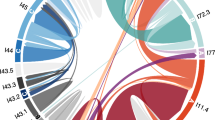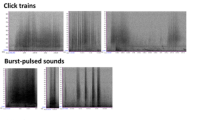Abstract
We investigated the influence of the type of activity and the social context on the proportion of four different structural categories of stereotyped calls in the acoustic communication of Kamchatkan killer whales. Using generalized linear models, we described the dependence of each sound category on the type of activity, the number of killer whale pods and the presence of mixed-pod groups. We found that the proportion of different sound categories depended on the number of pods and the presence of mixed-pod groups, while the type of activity did not affect the proportion of sounds of different categories. Based on the observed differences we suggest that biphonic and high-frequency monophonic calls are mainly used as family and pod markers, and help to track the position of family members at long ranges, and low-frequency monophonic calls are used as close-range intra-group signals to maintain contact between pod members in the conditions of limited underwater visibility.
Similar content being viewed by others
References
Aubin, T., Jouventin, P., and Hildebrand, C., Penguins use the two-voice system to recognize each other, Proc. R. Soc. Lond. B, 2000, vol. 267, pp. 1081–1087.
Bigg, M.A., MacAskie, I., and Ellis G., Photo-identification of individual killer whales, Whalewatcher, 1983, vol. 17, pp. 3–5.
Burdin, A.M., Hoyt, E., Sato, H., Tarasyan, K.K., and Filatova, O.A., Resident and transient-type killer khales, Orcinus orca, in Southeast Kamchatka, Russia, IWC Report SC/56/SM15, 2005.
Cheney, D.L., Seyfarth, R.M., and Silk, J.B., The role of grunts in reconciling opponents and facilitating interactions among adult female baboons, Anim. Behav., 1995, vol. 50, pp. 249–257.
Clark, C.W., The acoustic repertoire of the southern right whale, a quantitative analysis, Anim. Behav., 1982, vol. 30, pp. 1060–1071.
Deecke, V.B., Ford, J.K.B., and Slater, P.J.B., The vocal behaviour of mammal-eating killer whales: communicating with costly calls, Anim. Behav., 2005, vol. 69, pp. 395–405.
Filatova, O.A., Fedutin, I.D., Burdin, A.M., and Hoyt, E., Using a mobile hydrophone stereo system for real-time acoustic localization of killer whales (Orcinus orca), Appl. Acoust., 2006, vol. 67, pp. 1243–1248.
Filatova, O.A., Fedutin, I.D., Burdin, A.M., and Hoyt, E., The structure of the discrete call repertoire of killer whales Orcinus orca from Southeast Kamchatka, Bioacoustics, 2007, vol. 16, pp. 261–280.
Filatova, O.A., Fedutin, I.D., Nagaylik, M.M., Burdin, A.M., and Hoyt, E., Usage of monophonic and biphonic calls by free-ranging resident killer whales (Orcinus orca) in Kamchatka, Russian Far East, Acta Ethol., 2009, vol. 12, pp. 37–44.
Foote, A.D., Osborne, R.W., and Hoelzel, A.R., Temporal and contextual patterns of killer whale (Orcinus orca) call type production, Ethology, 2008, vol. 114, pp. 599–606.
Ford, J.K.B., Acoustic behavior of resident killer whales (Orcinus orca) off Vancouver Island, British Columbia, Can. J. Zool., 1989, vol. 67, pp. 727–745.
Ford, J.K.B., Vocal traditions among resident killer whales (Orcinus orca) in coastal waters of British Columbia, Can. J. Zool., 1991, vol. 69, pp. 1454–1483.
Ford, J.K.B., Ellis, G.M., Barrett-Lennard, L.G., Morton, A.B., Palm, R.S., and Balcomb, K.C., Dietary specialization in two sympatric populations of killer whales (Orcinus orca) in coastal British Columbia and adjacent waters, Can. J. Zool., 1998, vol. 76, pp. 1456–1471.
Ford, J.K.B., Ellis, G.M., Matkin, C.O., Wetklo, M.H., Barrett-Lennard, L.G., and Withler, R.E., Shark predation and tooth wear in a population of northeastern Pacific killer whales (Orcinus orca), Aquat. Biol., 2011, vol. 11, pp. 213–224.
Gautier, J.P. and Gautier, A., Communication in Old World monkeys, in How Animals Communicate, Bloomington: Indiana University Press, 1977, pp. 890–964.
Graham, M.A. and Noonan, M., Call types and acoustic features associated with aggressive chase in the killer whale (Orcinus orca), Aquat. Mamm., 2010, vol. 36, pp. 9–18.
Harcourt, A.H., Stewart, K.J., and Hauser, M., Functions of wild gorilla “close” calls. I. Repertoire, Context, and Interspecific Comparison, Behaviour, 1993, vol. 124, pp. 89–122.
Henderson, E.E., Hildebrand, J.A., Smith, M.H., and Falcone, E.A., The behavioural context of common dolphin (Delphinus sp.) vocalizations, Marine Mammal Science, 2012, vol. 28, pp. 439–460.
Ivkovich, T.V., Filatova, O.A., Burdin, A.M., Sato, H., and Hoyt, E., The social organization of resident-type killer whales (Orcinus orca) in Avacha Gulf, Northwest Pacific, as revealed through association patterns and acoustic similarity, Mamm. Biol., 2010, vol. 75, pp. 198–210.
Janik, V.M., Food-related bray calls in wild bottlenose dolphins Tursiops truncatus, Proc. R. Soc. Lond. B, 2000, vol. 267, pp. 923–927.
Janik, V.M. and Slater, P.J.B., Context-specific use suggests that bottlenose dolphin signature whistles are cohesion calls, Anim. Behav., 1998, vol. 56, pp. 829–838.
Lammers, M.O., Schotten, M., and Au, W.W.L., The spatial context of free-ranging Hawaiian spinner dolphins (Stenella longirostris) producing acoustic signals, J. Acoust. Soc. Am., 2006, vol. 119, pp. 1244–1250.
Marler, P., Bird calls: their potential for behavioral neurobiology, Birdsong. Ann. NY Acad. Sci., 2004, vol. 1016, pp. 31–44.
Macedonia, J.M., Individuality in a contact call of the ring-tailed lemur (Lemur catta), American J. Primatology, 1986, vol. 11, pp. 163–179.
MacKinnon, J., The behaviour and ecology of wild orangutans (Pongo pygmaeus), Anim. Behav., 1974, vol. 22, pp. 3–74.
Miller, P.J.O., Mixed-directionality of killer whale stereo-typed calls. a direction of movement cue? Behav. Ecol. Sociobiol., 2002, vol. 52, pp. 262–270.
Miller, P.J.O., Diversity in sound pressure levels and estimated active space of resident killer whale vocalizations, J. Compar. Physiol. A, 2006, vol. 192, pp. 449–459.
Oda, R., Effects of contextual and social variables on contact call production in free-ranging ringtailed lemurs (Lemur catta), Int. J. Primatol., 1996, vol. 17, pp. 191–205.
Oleson, E.M., Calambokidis, J., Burgess, W.C., McDonald, M.A., LeDuc, C.A., and Hildebrand, J.A., Behavioural context of call production by eastern North Pacific blue whales, Mar. Ecol. Prog. Ser., 2007, vol. 330, pp. 269–284.
R Development Core Team, R. A language and environment for statistical computing, Vienna, Austria, R Foundation for Statistical Computing, 2011.
Snowdon, C.T., Vocal communication in New World monkeys, J. Hum. Evol., 1989, vol. 18, pp. 611–633.
Saulitis, E.L., Matkin, C.O., and Fay, F.H., Vocal repertoire and acoustic behaviour of the isolated AT1 killer whale subpopulation in southern Alaska, Can. J. Zool., 2005, vol. 83, pp. 1015–1029.
Thomsen, F., Franck, D., and Ford, J.K.B., On the communicative significance of whistles in wild killer whales (Orcinus orca), Naturwissenschaften, 2002, vol. 89, pp. 404–407.
Volodin, I.A., Nagaylik, M.M., and Volodina, E.V., Cues to orientation of a caller to a listener in biphonic and non-biphonic close range contact calls in the dhole (Cuon alpinus), in Advances in Bioacoustics 2, Dissertationes Classis IV: Historia Naturalis, Slovenian Academy of Sciences and Arts (Ljubljana), 2006, vol. 47, no. 3, pp. 245–255.
Volodina, E.V., Volodin, I.A., Isaeva, I.V., and Unck, C., Biphonation may function to enhance individual recognition in the dhole, Cuon alpinus, Ethology, 2006, vol. 112, pp. 815–825.
Weilgart, L.S. and Whitehead, H., Vocalizations of the North Atlantic pilot whale (Globicephala melas) as related to behavioural contexts, Behav. Ecol. Sociobiol., 1990, vol. 26, pp. 399–402.
Weiβ, B.M., Symonds, H., Spong, P., and Ladich, F., Intra- and intergroup vocal behavior in resident killer whales, Orcinus orca, J. Acoust. Soc. Am., 2007, vol. 122, pp. 3710–3716.
Zuur, A.F., Ieno, E.N., Walker, N.J., Saveliev, A.A., and Smith, G.M., Mixed Effects Models and Extensions in Ecology with R, New York: Springer, 2009.
Author information
Authors and Affiliations
Corresponding author
Additional information
Original Russian Text © O.A. Filatova, M.A. Guzeev, I.D. Fedutin, A.M. Burdin, E. Hoyt, 2013, published in Zoologicheskii Zhurnal, 2013, vol. 92, No. 5, pp. 612–618.
The article was translated by the authors.
Rights and permissions
About this article
Cite this article
Filatova, O.A., Guzeev, M.A., Fedutin, I.D. et al. Dependence of killer whale (Orcinus orca) acoustic signals on the type of activity and social context. Biol Bull Russ Acad Sci 40, 790–796 (2013). https://doi.org/10.1134/S1062359013090045
Received:
Published:
Issue Date:
DOI: https://doi.org/10.1134/S1062359013090045




